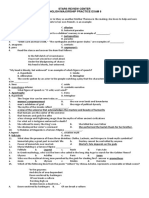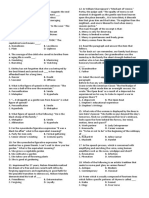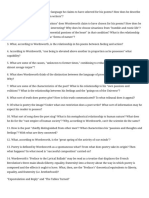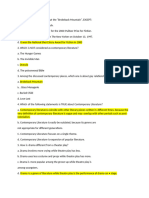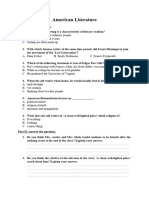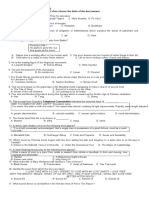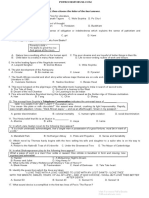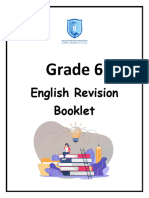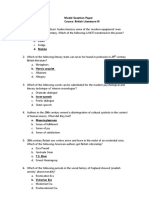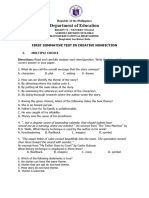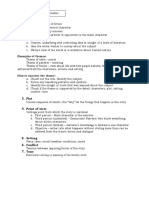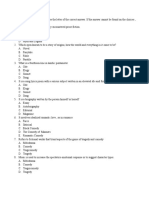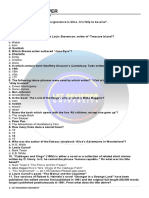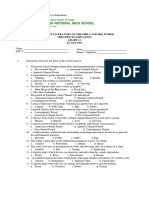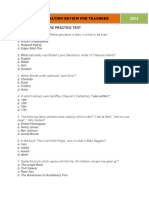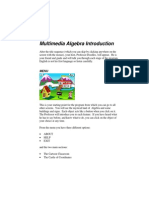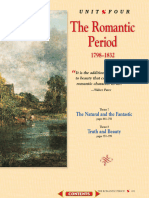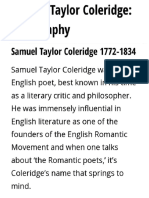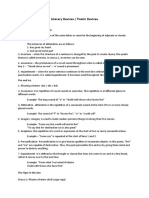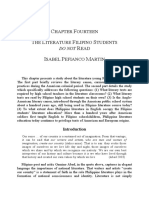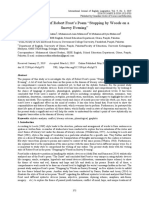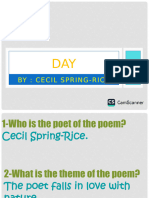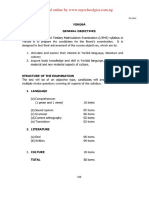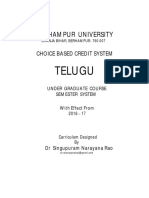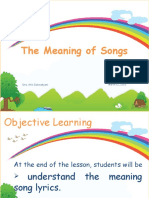Literature Introduction To The Short Story
Literature Introduction To The Short Story
Uploaded by
Robert KikahCopyright:
Available Formats
Literature Introduction To The Short Story
Literature Introduction To The Short Story
Uploaded by
Robert KikahOriginal Description:
Original Title
Copyright
Available Formats
Share this document
Did you find this document useful?
Is this content inappropriate?
Copyright:
Available Formats
Literature Introduction To The Short Story
Literature Introduction To The Short Story
Uploaded by
Robert KikahCopyright:
Available Formats
Literature INTRODUCTION TO THE SHORT STORY, PART 1/ THE SHORT STORY,
Customer Question
1. During what part of "Bernice Bobs Her Hair" does Bernice cut Marjorie's braids? A. Climax B. Rising action C. Falling action D. Epiphany 2. The label detective novel is an example of A. a character study. B. informational reading. C. a genre. D. a universal truth. 3. Which one of the following types of writing would most likely be fiction? A. Novel B. Essay C. Autobiography D. Informational literature 4. Which one of the following terms best describes the period of the 1920s? A. Proper B. Moral C. Rebellious D. Symbolic 5. Suppose you've just read a romance novel that has stock characters and a happily-ever-after ending. What kind of literature were you probably reading? A. Escapist literature B. Informational literature C. Interpretive literature D. Universal literature 6. Because Bernice changes during the course of "Bernice Bobs Her Hair," she's said to be a _______ character. A. one-dimensional B. symbolic C. static D. dynamic
7. Which one of the following genres presents the author's personal ideas and feelings about a particular topic? A. Short story B. Novel C. Poem D. Essay 8. What are conventions? A. The events that lead to the climax of a novel B. The conflicts between the protagonist and the antagonist C. The traditions and rules that lead to a reader's expectations D. The difficulties a writer encounters in creating characters 9. Which one of the following events in "Bernice Bobs Her Hair" is an example of an epiphany? A. Bernice suddenly understands how others see her. B. Marjorie dares Bernice to get her hair bobbed. C. Warren begins to come to visit Bernice. D. G. Reece Stoddard cuts in on Bernice's dance partner. 10. In "A White Heron," how does Sarah Jewett portray Sylvia's attitude about money? A. Sylvia doesn't really care about money at all. B. Sylvia hopes the hunter will give her some money no matter what she does. C. Sylvia struggles between protecting the heron and gaining the money. D. Sylvia was once rich and has now fallen on hard times. 11. Shakespeare's Romeo and Juliet is an example of A. an old-fashioned novel. B. interpretative literature. C. escapist literature. D. a perfect short story. 12. What is Sarah Jewett suggesting when she writes about Sylvia's increasing attraction to the hunter in "A White Heron"? A. Sylvia will do anything for money. B. Sylvia is experiencing falling in love. C. Sylvia cares more about people than animals. D. Sylvia does one thing but believes the opposite. 13. In "Bernice Bobs Her Hair," Bernice is the _______ in the story. A. symbol of fun B. stock character C. protagonist D. genre
14. Which one of the following items is an example of a symbol in "Bernice Bobs Her Hair"? A. Marjorie's talk with her mother B. Bernice's car C. The dinner-dance at the country club D. Bernice's haircut 15. The connotative meaning of a word refers to A. its dictionary definition. B. what it suggests about something. C. the irony suggested by the word. D. its meaning at a specific time in history. 16. The term realism refers to A. making things better than they actually are. B. describing things just as they are. C. using as much descriptive language as possible. D. allowing the reader to draw his or her own conclusions. 17. The most significant conflict in "Bernice Bobs Her Hair" is between A. Warren and Marjorie. B. Marjorie and men in general. C. Bernice and Marjorie. D. Bernice and herself. 18. Interpretative literature is said to be interactive because A. you can read most of these works on the Internet now. B. the conflict shows the interaction between two elements of the story. C. the story consists of a rising action and a falling action. D. the reader has to take part in discovering the meaning of the work. 19. Which one of the following events is an example of situational irony? A. Bernice cuts her hair and suddenly realizes what a mistake it is. B. Bernice overhears Marjorie talking with her mother. C. Warren is disappointed that Bernice cuts her hair. D. Marjorie teaches Bernice how to be more socially accepted. 20. The events that take place in a story make up the story's A. genre. B. plot. C. setting. D. climax. 1. In "A Pair of Silk Stockings," the silk stockings are a symbol of A. Mrs. Sommers's inability to handle money. B. Mrs. Sommers's lack of concern for her children.
C. Mrs. Sommers's selfish needs. D. Mrs. Sommers's desire for attention. 2. An author's purpose in using rhetoric is to A. create a certain effect for the reader. B. present facts as they really are. C. provide hints as to what's going to happen. D. separate realism from idealism. 3. The wicked witch and the big bad wolf are examples of A. dynamic characters. B. archetypes. C. protagonists. D. anecdotes. 4. Faith's pink ribbons are an example of a A. genre. B. parable. C. fable. D. symbol. 5. In "Paul's Case," members of the faculty don't like Paul's carnation because they think A. it's effeminate for a man to wear a flower. B. it doesn't match his other clothing. C. it suggests that he's not taking things seriously. D. it's the mark of an early death. 6. Which one of the following short stories is an example of an allegory? A. "Paul's Case" B. "The Private History of a Campaign That Failed" C. "Young Goodman Brown" D. "A Pair of Silk Stockings" 7. An individuated character is one who A. has his or her own unique history and personality. B. is a symbol for some characteristic. C. is able to be identified with the audience. D. has a series of epiphanies. 8. In the story "Paul's Case," why is Paul irritated and wretched after the concert? A. He has seen his English teacher. B. He has spoken with the singer. C. His real life is so different from his dream. D. He has to walk home in the rain.
9. Paul's tattered clothes are a symbol of his A. rebellious nature. B. unconcern about what he looked like. C. desire to insult the faculty. D. economic circumstances. 10. In "The Private History of a Campaign That Failed," Twain writes, "We were equal to the occasion. In our response there was no hesitation, no indecision" (71). This type of writing is an example of A. a motif. B. hypocrisy. C. an anecdote. D. mock heroics. 11. What author saw hypocrisy in the lives of the Puritans? A. Willa Cather B. Mark Twain C. Nathaniel Hawthorne D. Kate Chopin 12. Which one of the following is characteristic of a character study? A. The protagonist is a static character. B. Getting a glimpse into the character's mind and heart is the most important element of the story. C. The character is usually tragicomicthat is, he or she is both funny and sad at different times. D. The character comes to an unhappy end. 13. Foreshadowing means A. showing the readers the dark side of a character's personality. B. describing what happens at nightfor example, in a dark basement. C. hinting at things that will occur later. D. putting secondary characters in the foreground of the story. 14. In "Paul's Case," why does Paul go to work early? A. He wanted to wrestle with the other boys. B. He didn't want to lose his job. C. He didn't want to get caught skipping school. D. He liked looking at the pictures in the art gallery. 15. Which one of the following statements best describes the theme of "Young Goodman Brown"? A. People aren't always what they seem. B. The Devil is in charge of this world. C. Men should listen to the cautions of their wives. D. The forest is a place where dark deeds take place.
16. In "Young Goodman Brown," what is meant by "a hoary corpse"? A. A respected person B. An extremely old dead body C. A promiscuous person D. A lonely man 17. What is the climax in Willa Cather's short story "Paul's Case"? A. Paul takes the train to New York. B. Paul reads about his theft in the newspaper. C. Paul jumps in front of the train. D. Paul meets the boy from Yale. 18. Which one of the following words best describes Goodman Brown at the end of Hawthorne's story? A. Relieved B. Innocent C. Safe D. Despairing 19. At the beginning of "Young Goodman Brown," Brown's wife says, "Pray tarry with me this night, dear husband, of all nights in the year" (1). This statement is an example of A. irony. B. ambiguity. C. foreshadowing. D. satire. 20. Which one of the following short stories takes a series of completely ordinary events and develops them into a character study? A. "Paul's Case" B. "A Private History of a Campaign That Failed" C. "Young Goodman Brown" D. "A Pair of Silk Stockings" 1. If you consider The Call of the Wild to be an allegory, which one of the following statements would be true? A. Judge Miller represents the primordial condition. B. Buck represents some characteristic of humanity. C. John Thornton represents the civilized world. D. The book is a story about the need for socialism. 2. On page 14 of The Call of the Wild, what's meant by the phrase "The domesticated generations fell from him"? A. Buck has lost a lot of hair in his fight with Spitz. B. Buck is learning to love a human being again. C. Buck is losing his civilized characteristics. D. Buck longs to return home to the Judge's family.
3. The survival of the fittest is an idea promoted by A. Carl Jung. B. Friedrich Nietzsche. C. Charles Darwin. D. Karl Marx. 4. In Buck's thinking, the "noblest" prey of all is A. another dog. B. a very fast rabbit. C. a moose. D. man. 5. The Yukon is the main _______ for this story. A. symbol B. genre C. plot D. setting 6. How did John Thornton die? A. He died from frostbite to his feet. B. He was killed by a group of wild wolves. C. He was killed by Native Americans. D. He died in the river rapids. 7. What does Buck often dream of as he sleeps by the campfire? A. Judge Miller's home B. Primitive man C. John Thornton D. His fight with Spitz 8. The term racial unconscious means that A. we're all racists at heart to some degree, even though we're unaware of it. B. each species and culture shares ancient memories, stored in the unconscious part of the mind. C. you must learn the law of club and fang to survive. D. nature weeds out the weakest and unfit. 9. What happens the first time Buck is beaten? A. He learns he has to obey men, but decides never to surrender inside. B. He has his spirit as well as his body crushed. C. He learns that he can't get away with stealing another dog's food. D. He swears that he'll someday have his revenge on Spitz. 10. The term hierarchy refers to
A. a team in which everyone is equal and has to pull his or her own weight. B. a power structure in which each member knows his or her own place. C. a situation in which higher species such as men will always be in control of lower species such as animals. D. a condition in which the weak must die so the strong can survive. 11. The purpose of the expedition Buck takes with Thornton and his partners is to A. search for a gold mine. B. find a new camp. C. deliver mail. D. hunt for food. 12. On page 14 of The Call of the Wild, Jack London writes, "In vague ways he remembered back to the youth of the breed." This statement is an example of A. the will to power. B. natural selection. C. survival of the fittest. D. the racial unconscious. 13. What breed of dog is Buck? A. St. Bernard and Scotch shepherd mix B. Husky and Scotch shepherd mix C. St. Bernard D. Husky 14. Mercedes's luggage is a symbol of A. her party's inexperience. B. civilization. C. her domination. D. her selfishness. 15. What word best describes the relationship between Buck and John Thornton? A. Friendship B. Trust C. Attachment D. Love 16. The death of Curly is an example of A. the theory of evolution. B. racial unconsciousness. C. the law of club and fang. D. the will to power. 17. The will to power is symbolized by A. Buck's killing Spitz.
B. Hal's arguing with Charles. C. Thornton's rifle. D. Buck's becoming friends with Thornton. 18. Frangois and Perrault are A. gold diggers from California. B. dog trainers from Alaska. C. agents of the Canadian government. D. drivers of the mail train. 19. Who saves Buck from impending death at the hands of Hal? A. John Thornton B. Judge Miller C. Frangois D. Perrault 20. Which one of the following words best describes Hal, Mercedes, and Charles? A. Sensitive B. Frightened C. Prepared D. Inexperienced 1. If this be error and upon me proved, I never writ, nor no man ever loved. These lines are an example of a/an A. quatrain. B. octet. C. couplet. D. sestet. 2. The line "I wandered lonely as a cloud" is an example of A. a metaphor. B. a simile. C. a couplet. D. alliteration. 3. In "Shall I Compare Thee to a Summer's Day?" Shakespeare claims that the object of his sonnet will be immortal because A. he'll always love her. B. she's for all seasons. C. she'll live on in his poem. D. she's like the summer's day. 4. Which one of the following sentences is an example of a metaphor? A. I am a rock.
B. She eats like a bird. C. I'm as hungry as a wolf. D. The breeze blew the branches back and forth. 5. The way Cowley uses the phrase "my own country" is an example of A. simile. B. consonance. C. repetition. D. personification. 6. The phrase "mid-May" is an example of A. assonance. B. consonance. C. alliteration. D. metaphor. 7. During the Romantic period, poets placed an emphasis on A. discipline. B. order. C. hierarchy. D. nature. 8. Which one of the following words is an iamb? A. Rachel B. Alice C. JoAnne D. Sally 9. The line "A tree whose hungry mouth is prest" is an example of iambic A. trimeter. B. pentameter. C. tetrameter. D. dimeter. 10. What is the most probable reason that rhyme and repetition first found their ways into poems? A. People wanted a beat they could dance to. B. They were written for the upper class. C. Heroes in epics tended to talk that way. D. The poems were easier to remember and pass on. 11. Which one of the poems you've read uses the words floats, fluttering, and dancing? A. "I Wandered Lonely as a Cloud" B. "Let Me Not to the Marriage of True Minds" C. "Shall I Compare Thee to a Summer's Day?" D. "The Long Voyage"
12. Emphasizing the importance of order, law, discipline, and tradition is typical of _______ literature. A. Romantic B. Classical C. discursive D. dramatic 13. Which one of the following phrases is an example of consonance? A. From rest and sleep, which but thy pictures be B. Sometime too hot the eye of heaven shines C. Drink to me only with thine eyes D. River birch and upland beech 14. Which one of the poems you've read has the rhyme scheme AA BB CC . . . ? A. "I Wandered Lonely as a Cloud" B. "Let Me Not to the Marriage of True Minds" C. "The Long Voyage" D. "Trees" 15. "Let Me Not to the Marriage of True Minds" is an example of which type of poem? A. Narrative B. Discursive C. Dramatic D. Descriptive 16. "Foam brightens like the dogwood now" is an example of A. a simile. B. a metaphor. C. alliteration. D. consonance. 17. The rhyme scheme of Shakespeare' s sonnets is A. AABB CCDD EEFF GG. B. ABAB CDCD EFEF GG. C. ABBA CDDC EFFE GG. D. ABCD ABCD ABCD GG. 18. Who are the "fools" mentioned in the poem "Trees"? A. Poets B. Gods C. Trees D. Robins
19. The repeated use of the "o" sound in "A host, of golden daffodils" is called A. consonance. B. assonance. C. alliteration. D. rhyme. 20. A definition of formal poetry is verse that A. sticks to certain traditional patterns. B. has no rhyme scheme. C. uses figurative language. D. is written in blank verse. 1. Hopkins's use of "seared," "bleared," and "smeared" is an example of A. metaphor. B. assonance. C. simile. D. alliteration. 2. A villanelle is A. a narrative poem written in blank verse. B. a formal poem using extensive repetition. C. a favorite technique of John Donne. D. a type of complex sonnet. 3. The form of the poem "God's Grandeur" is that of A. an English sonnet. B. an Italian sonnet. C. a villanelle. D. blank verse. 4. In "The New Colossus," the Statue of Liberty is compared to a/an A. European queen. B. mother. C. immigrant. D. door. 5. In the poem "God's Grandeur," the phrase "nor can foot feel, being shod" means A. God cures all pain. B. the poet can sense God from head to toe. C. the earth is home for humans. D. humans are out of touch with nature. 6. In Donne's sonnet, what does the phrase "one short sleep past" mean? A. Death comes sooner than expected. B. Death is more permanent than sleep.
C. Death, like a nap, isn't permanent. D. Death is unavoidable. 7. Describing the chariot that bears the human soul as "frugal" is an example of A. paradox. B. denotation. C. epiphany. D. realism. 8. What type of poem is "Death, Be Not Proud"? A. Narrative B. Reflective C. Descriptive D. Discursive 9. Who is the speaker in Sandburg's "Grass"? A. A conductor B. A passenger C. The grass D. Napoleon 10. Which one of the following poems depends heavily on the use of allusion for effect? A. "God's Grandeur" B. "Do Not Go Gentle into That Good Night" C. "Grass" D. "Death, Be Not Proud" 11. A tercet is a A. figure of speech. B. literary genre. C. complex rhyme scheme. D. three-line stanza. 12. Which poet, who seems be using iambic pentameter, bends the meter most? A. Emily Dickinson B. John Donne C. Gerard Manley Hopkins D. Emma Lazarus 13. Which one of the following elements is characteristic of the poem "Richard Cory"? A. Surprise ending B. Blank verse C. Lack of rhyme scheme D. Sonnet form
14. Which one of the following poems is a sonnet? A. "The Red Wheelbarrow" (Great Short Poems, page 48) B. "Stopping by Woods on a Snowy Evening" (Great Short Poems, page 44) C. "Into My Own" (Songs for the Open Road, page 17) D. "Travel" (Songs for the Open Road, page 35) 15. In "Death, Be Not Proud," what two things does Donne say give pleasure? A. Nature and travel B. God and salvation C. Rest and sleep D. Life and death 16. To paraphrase a poem means to A. rewrite it in one's own words. B. determine the rhyme scheme. C. analyze the meter. D. summarize its theme. 17. In "Death, Be Not Proud," the speaker is addressing his words to A. his father. B. an old man. C. Death. D. God. 18. What is the rhyme scheme in "How Doth the Little Crocodile" on page 29 of Great Short Poems? A. AABB CCDD B. ABBA ABBA C. ABAB ABAB D. ABAB CDCD 19. Which one of the following poems is written in free verse? A. "Grass" B. "There Is No Frigate Like a Book" C. "Death, Be Not Proud" D. "God's Grandeur" 20. Which one of the following lines is written in iambic pentameter? A. "I lift my lamp beside the golden door" B. "When the proofs, the figures, were ranged in columns before me" C. "Not that the pines are darker there" D. "And sorry I could not travel both" 1. When does the Narrative of Sojourner Truth take place?
A. Before the Civil War B. During the Civil War C. After the Civil War D. Right after the Emancipation Proclamation 2. In "Life without Principle," Thoreau writes, "I would have had him deal with his privatest experience, as the poet does." What does this statement mean? A. People should speak from their hearts and say what's on their minds. B. Speeches should employ figurative (poetic) language to get their points across. C. Courtrooms are places where people traditionally lie. D. People talk only about trivial things. 3. What does Seattle say about integrating white and Native American cultures? A. It's going to be difficult, but it's the only way both cultures can survive. B. It will be impossible, because the two traditions are too different. C. It will happen naturally when the railroads open the West to the whites. D. It can be prevented only if the tribes unite to fight the whites. 4. What is Sojourner Truth's attitude toward the Bible? A. She depends on professional theologians to make sense of it for her. B. She believes that every word in the Bible is from God. C. She accepts as true only what's true in her own experience. D. She says it's a tool of whites to explain that slavery is morally acceptable. 5. Thoreau believes that people should work because A. God said so in the Bible. B. it will give them time to think about important things. C. they love what they do. D. it will keep them out of trouble. 6. When Tecumseh says, "Where today is the Pequot? Where the Narragansetts, the Mohawks?" he is A. asking why all the tribes haven't come to the council. B. indicating what happens to tribes that don't unite against the whites. C. implying that these tribes aren't as brave as their reputations suggest. D. boasting that his tribe had conquered these tribes and can do the same to the whites. 7. What did Thoreau have in common with John Thornton in The Call of the Wild? A. A dislike of government B. A love of hunting C. A mistrust of religion D. An enjoyment of solitude 8. Matthias is an example of a/an A. cult leader. B. typical slave owner.
C. pagan god. D. runaway slave. 9. In "Life without Principle," Thoreau writes, "If my wants should be much increased, the labor required to supply them would become a drudgery." What does this statement mean? A. If you don't want much, you don't have to spend as much time being miserable working to get it. B. Work is meaningful only when you think about what you'll be able to do with the money you earn. C. Slavery was wrong because it meant that some people worked hard to satisfy other people's wants. D. The more you have, the more you want. 10. In emphasizing the importance of individual thinking and basing one's beliefs on one's own experiences, Sojourner shows she has much in common with A. Chief Pontiac. B. Chief Seattle. C. Thoreau. D. Matthias. 11. What one thing does Thoreau say stifles poetry and philosophy? A. Crime B. Goverment C. Business D. Laws 12. The major theme of "Life without Principle" is A. freedom. B. economics. C. religion. D. government. 13. Tecumseh's "Let the white race perish" speech is A. a plea to the people's reason. B. an appeal to the emotions of his listeners. C. a logical list of reasons why the whites should be resisted. D. a satire on the white race and its traditions. 14. At first, Sojourner Truth was happy to have many children because A. it took her mind off her problems. B. they could help her with her daily tasks. C. they were the only things that gave her joy. D. it provided more slaves for her owner. 15. The story of The Wolf used by Chief Pontiac is an example of A. a simile.
B. a myth. C. personification. D. an autobiography. 16. The Narrative of Sojourner Truth was written down by A. Isabella Baumfree. B. Charles Ardinburgh. C. Olive Gilbert. D. Robert Matthews (Matthias). 17. When Chief Seattle refers several times to the angry young men in his tribe, he's A. trying to convince his audience to be more peaceable. B. urging his audience to unite against the whites. C. making veiled threats. D. blaming the tribal leaders. 18. The statement "There was snow on the ground, . . . and a large old-fashioned sleigh was seen to drive up to the door of the late Col. Ardinburgh" is an example of A. interior monologue. B. social commentary. C. metaphor. D. exterior narrative. 19. Sojourner's vision of God is an example of a/an A. myth. B. simile. C. epiphany. D. exterior narrative. 20. "Yonder sky has wept tears of compassion" is an example of A. alliteration. B. personification. C. consonance. D. assonance. 1. "The best in this kind are but shadows" is A. Titania talking about men. B. Theseus talking about plays. C. Demetrius talking about the women he has loved in the past. D. Bottom talking about his fellow craftsmen. 2. One difference between tragedy and comedy is that tragedy A. uses supernatural elements. B. usually features an extraordinary hero. C. makes us laugh at ourselves, not others. D. uses metaphor and analogy to make its point.
3. When are the following lines spoken? If we shadows have offended, Think but this, and all is mended, That you have but slumber'd here, While these visions did appear. A. When Hermia and Lysander are talking B. Right before Puck casts a spell on Bottom C. When Theseus and Hippolyta are talking about their wedding D. At the very end of act 5 4. What does the speech in question 3 mean? A. The audience should be offended by the poor acting. B. It the audience thinks it's a bad play, it's not the actors' fault. C. If there were flaws in the play, the audience should think they were dreaming. D. The playwright will try to do a better job the next time. 5. Dramatic irony means that A. the cosmos, state, family, and individual follow the same pattern. B. the audience knows something the character or characters don't. C. things are going to end very badly for someone. D. everything works out in the end. 6. Egeus wants his daughter to A. marry Demetrius. B. marry Lysander. C. be executed. D. enter a convent. 7. In act 3, who says the following lines to Bottom? Out of this wood do not desire to go: Thou shalt remain here, whether thou wilt or no. I am a spirit of no common rate. A. Titania B. Puck C. Oberon D. Cobweb 8. In act 4, what do the following lines mean? Fairy King, attend, and mark: I do hear the morning lark. A. The enchantment on Bottom is about to end. B. Titania is about to fall in love with Bottom. C. Theseus and Hippolyta are arriving.
D. The sun is coming up and the fairies should leave. 9. During the Renaissance, dramatists began writing about A. science. B. religion. C. history. D. everyday people. 10. In act 5, why does Hippolyta believe the lovers' story of their time in the forest? A. She believes the women because she's a queen. B. She wants to defend the lovers. C. The lovers' stories all match. D. She wants to oppose Egeus. 11. Humanists believe that A. love is an illusion. B. life on earth is important in its own right. C. humans and animals existed on the same level. D. Shakespeare didn't actually write the plays we think he did. 12. To whom is Helena speaking when she says, "If you were civil and knew courtesy,/You would not do me thus much injury" (act 3, scene 2)? A. Hermia only B. Lysander and Demetrius C. Demetrius and Hermia D. Hermia and Lysander 13. According to Renaissance philosophy, commoners often represent A. reason. B. love. C. pride. D. appetite. 14. Who speaks the line "Lord, what fools these mortals be"? A. Puck B. Cobweb C. Oberon D. Mustardseed 15. Who says "The course of true love never did run smooth"? A. Titania B. Bottom C. Lysander D. Demetrius
16. The ability of writers to completely identify with their characters is A. negative capability. B. ambiguity. C. hypocrisy. D. satire. 17. Using pairs of opposites, such as Helena and Hermia, is called A. realism. B. irony. C. doubling. D. foreshadowing. 18. The craftsmen in the play speak in prose because A. too much blank verse gets tiresome. B. Theseus would have forbidden them to use verse. C. that kind of common language symbolizes their status in life. D. it's the language of love. 19. In act 1, the reader learns that Hermia's father refuses to allow her to marry Lysander. What do Hermia and Lysander plan to do to counteract his refusal? A. Run away to be married. B. Use a potion to convince Hermia's father. C. Go together to talk to Hermia's mother. D. Take their case to Theseus, Duke of Athens. 20. Read the following passage from act 3, scene 2. So we grew together, Like to a double cherry, seeming parted, But yet an union in partition; In this passage, Helena is referring both to herself and to A. Titania. B. Lysander. C. Oberon. D. Hermia. Thank you for all your help, the program i', using is Penn Foster tiffany Submitted: 7 years ago. Category: Homework
Expert: Sk1llz replied 7 years ago.
Here are your answers in the order you wrote them. 1C 2C 3A 4C 5A 6D 7D 8C 9A 10C 11B 12B 13C 14D 15B 16B 17C 18D 19A 20B ---------1A 2A 3A 4D 5C 6C 7A 8C 9D 10D 11C 12B 13C 14D 15A 16B 17C 18D 19C 20A ---------1B 2C 3C 4D 5D 6C 7B 8B 9A 10B 11A 12D 13A 14B 15D 16A 17A 18D 19A 20D ----------1A 2B 3C 4A 5D 6C 7D 8C 9C 10D 11A 12B 13D 14D 15C 16B 17B 18A 19B 20A ---------1B 2B 3B 4B 5D 6A 7A 8B 9C 10B 11D 12C 13A 14C 15C 16A 17C 18D 19A 20A ---------1A 2A 3B 4C 5C 6B 7D 8A 9A 10C 11C 12A 13B 14D 15B 16C 17D 18D 19C 20B ---------1B 2A 3D 4C 5B 6A 7A 8D 9C 10C 11B 12B 13B 14A 15C 16A 17C 18C 19A 20D
You might also like
- English Major LET ReviewerDocument9 pagesEnglish Major LET ReviewerJay Telan II86% (7)
- English Majorship 6Document10 pagesEnglish Majorship 6Jovel Figuerres100% (2)
- Three Plays: Our Town, The Matchmaker, and The Skin of Our TeethFrom EverandThree Plays: Our Town, The Matchmaker, and The Skin of Our TeethRating: 4 out of 5 stars4/5 (76)
- Cpel Midterm ExamDocument11 pagesCpel Midterm Exammike galang100% (2)
- English Major LET Reviewer PDFDocument6 pagesEnglish Major LET Reviewer PDFMaria Virginia Fernandez100% (1)
- Midterm Exam in Creative Nonfiction 12Document3 pagesMidterm Exam in Creative Nonfiction 12Ma. April L. Gueta100% (13)
- Week 8 s2 Reading Writing Mock TestDocument6 pagesWeek 8 s2 Reading Writing Mock TestNg phwNo ratings yet
- LET Reviewer Major in EnglishDocument3 pagesLET Reviewer Major in EnglishAnonymous qNShsh5HDa100% (3)
- Final Coaching Part 2Document5 pagesFinal Coaching Part 2Andrew T. Oribiana100% (1)
- Math For The Office Professional: Study UnitDocument141 pagesMath For The Office Professional: Study UnitRobert KikahNo ratings yet
- Penn Foster Biology ExaminatonDocument4 pagesPenn Foster Biology ExaminatonRobert KikahNo ratings yet
- Wordsworth QuestionsDocument5 pagesWordsworth QuestionsParthiva Sinha0% (1)
- Abcdef 162Document20 pagesAbcdef 162Catlyn Dagami De GuzmanNo ratings yet
- 21st CenturyDocument5 pages21st CenturyJay Cariel GastonesNo ratings yet
- American LiteratureDocument11 pagesAmerican LiteratureMinh Đức NguyễnNo ratings yet
- 21st Century Literature 1 FinalDocument6 pages21st Century Literature 1 FinalRegidor AnalynNo ratings yet
- English ReviewerDocument3 pagesEnglish ReviewerGrace Joy BuenaflorNo ratings yet
- 21st Century Written Test - 4th QDocument9 pages21st Century Written Test - 4th Qirene.lumambas001No ratings yet
- A230B BOOK 2 James Joyce's-1Document12 pagesA230B BOOK 2 James Joyce's-1marzooqalzafiriNo ratings yet
- LET Developmental Reading QUIZDocument4 pagesLET Developmental Reading QUIZJerico Llovido50% (2)
- PDF English Major Let ReviewerDocument6 pagesPDF English Major Let ReviewerJenevhen AbellaNo ratings yet
- 21st Activity 2.1Document2 pages21st Activity 2.1cherish mae oconNo ratings yet
- Eg237 Lit Lsa 1ST Term Exams 2023Document6 pagesEg237 Lit Lsa 1ST Term Exams 2023Rodrigue NgongmiNo ratings yet
- Unit 1 PracticeDocument4 pagesUnit 1 Practice030437210191No ratings yet
- Quarter Exam 21st 2018Document8 pagesQuarter Exam 21st 2018Mark Jay Quintos BongolanNo ratings yet
- Unit 1 PracticeDocument4 pagesUnit 1 PracticePhuong Thao LeNo ratings yet
- 105 - English Let ReviewDocument6 pages105 - English Let ReviewBlessie Marie SamontañezNo ratings yet
- Read Each Question Carefully. Choose The Letter of The Correct AnswerDocument2 pagesRead Each Question Carefully. Choose The Letter of The Correct AnswerSage Capinlac OlajayNo ratings yet
- It Is A Truth Universally Acknowledged That A Single Man in Possession of A Good Fortune, Must Be in Want of A WifeDocument8 pagesIt Is A Truth Universally Acknowledged That A Single Man in Possession of A Good Fortune, Must Be in Want of A WifeJaycelyn BaduaNo ratings yet
- 3rd REVIEW TEST 2023 2024Document5 pages3rd REVIEW TEST 2023 2024graale198No ratings yet
- 21st Century Literatures From The Philippines FinalDocument10 pages21st Century Literatures From The Philippines FinalArnel LomocsoNo ratings yet
- Grade 6 - English Revision Booklet.Document17 pagesGrade 6 - English Revision Booklet.raniaabdallah91No ratings yet
- PRACTICE văn học anh mỹDocument6 pagesPRACTICE văn học anh mỹLương Thị TâmNo ratings yet
- Midterm Exam in Creative Nonfiction 12docxDocument4 pagesMidterm Exam in Creative Nonfiction 12docxRay Patriarca100% (1)
- TAB1 Mock Test (With Keys)Document7 pagesTAB1 Mock Test (With Keys)Khang ĐinhNo ratings yet
- British Literature-IIIDocument5 pagesBritish Literature-IIIjean de franceNo ratings yet
- 130 For StudentsDocument8 pages130 For Studentsalimbk61No ratings yet
- SS2 literature-WPS OfficeDocument2 pagesSS2 literature-WPS Officebettycokker554No ratings yet
- Questionnaire 4Document4 pagesQuestionnaire 4forsythiachrysanthemumNo ratings yet
- Creative - 1st Periodic TestDocument3 pagesCreative - 1st Periodic TestWinshel Peñas AñonuevoNo ratings yet
- Tect ReviewDocument8 pagesTect ReviewrozilawatyNo ratings yet
- Read Each Question and Answer Carefully and Choose The ONE Best Answer. Try To Answer All QuestionsDocument6 pagesRead Each Question and Answer Carefully and Choose The ONE Best Answer. Try To Answer All QuestionsAomme JogthongNo ratings yet
- Diagnostic Test in 21ST Century Literature From The Philippines and The World FinalDocument5 pagesDiagnostic Test in 21ST Century Literature From The Philippines and The World FinalAzariah PayNo ratings yet
- First Summative Test in CNF 2023Document7 pagesFirst Summative Test in CNF 2023ANGELIE CRISTINE POMADONo ratings yet
- Midterm Exam LitDocument4 pagesMidterm Exam LitHelmer Felix PascualNo ratings yet
- Challenge Thy MindDocument4 pagesChallenge Thy MindBrielle Manuel100% (3)
- Trắc Nghiệm VHMDocument15 pagesTrắc Nghiệm VHMNguyễn Bảo ChâuNo ratings yet
- Character: 2 Key Elements of LiteratureDocument13 pagesCharacter: 2 Key Elements of LiteratureKris Mea Mondelo MacaNo ratings yet
- Creative Nonfiction-1st-Q-ExamDocument5 pagesCreative Nonfiction-1st-Q-ExamMosmirah Abduljalil - AbbasNo ratings yet
- Read Each Question and Answer Carefully and Choose The ONE Best Answer. Try To Answer All QuestionsDocument6 pagesRead Each Question and Answer Carefully and Choose The ONE Best Answer. Try To Answer All QuestionsAomme JogthongNo ratings yet
- Multiple ChoiceDocument4 pagesMultiple ChoiceXander Mina BañagaNo ratings yet
- Name: Vania Lailatul Istianah Nim: 19018060: Tugas Review Text Read The Following Text and Answer The QuestionsDocument9 pagesName: Vania Lailatul Istianah Nim: 19018060: Tugas Review Text Read The Following Text and Answer The QuestionsVania Lailatul IstianahNo ratings yet
- English Reviewer IDocument4 pagesEnglish Reviewer ImaryjeandolinoNo ratings yet
- Alfanuari Adv Reading Week 10Document9 pagesAlfanuari Adv Reading Week 10Bambang SatoNo ratings yet
- Midterm Exam PretestDocument4 pagesMidterm Exam PretestAzza ZzinNo ratings yet
- The Story of A Real Person's Life Written by Someone Other Than That PersonDocument2 pagesThe Story of A Real Person's Life Written by Someone Other Than That PersonCarmie Lactaotao DasallaNo ratings yet
- CNF SummativeTest2Document2 pagesCNF SummativeTest2Mindoron, Meljoy L.100% (2)
- English Literature 234Document6 pagesEnglish Literature 234Patrick MendozaNo ratings yet
- General Education 2Document7 pagesGeneral Education 2HazelNo ratings yet
- English Part 1 General Education (Gen Ed) LET ReviewerDocument4 pagesEnglish Part 1 General Education (Gen Ed) LET ReviewerRosito BaragoNo ratings yet
- Essay FredrickDocument1 pageEssay FredrickRobert KikahNo ratings yet
- Administrative Office ProceduresDocument125 pagesAdministrative Office ProceduresRobert Kikah100% (4)
- History - Study GuideDocument227 pagesHistory - Study GuideRobert KikahNo ratings yet
- History - Study GuideDocument227 pagesHistory - Study GuideRobert KikahNo ratings yet
- CanTEST Info Book FinalDocument20 pagesCanTEST Info Book FinaldrkmskNo ratings yet
- Synthetic DivisionDocument6 pagesSynthetic DivisionRobert KikahNo ratings yet
- World History QuizDocument4 pagesWorld History QuizRobert KikahNo ratings yet
- ABE - Introduction To Quantitative MethodsDocument326 pagesABE - Introduction To Quantitative MethodsEbooks Prints80% (5)
- Preventing Injury: Study UnitDocument42 pagesPreventing Injury: Study UnitRobert KikahNo ratings yet
- Havya Patel-Counselor's ReccommendationDocument2 pagesHavya Patel-Counselor's ReccommendationRobert KikahNo ratings yet
- Multimedia Algebra IntroductionDocument9 pagesMultimedia Algebra IntroductionRobert KikahNo ratings yet
- Parts of SpeechDocument86 pagesParts of SpeechRobert KikahNo ratings yet
- KEBS Pre-Export ConformityDocument1 pageKEBS Pre-Export ConformityRobert KikahNo ratings yet
- Organic ChemistryDocument76 pagesOrganic Chemistryapi-3738901100% (2)
- English Paper IIIDocument8 pagesEnglish Paper IIIpicasso1011221No ratings yet
- Haiku: History of The Haiku FormDocument8 pagesHaiku: History of The Haiku FormKim HyunaNo ratings yet
- Sum Subjects in AbmDocument37 pagesSum Subjects in AbmKiel BeatrizeNo ratings yet
- A Different HistoryDocument14 pagesA Different Historyshyamcharansai.raghupathiNo ratings yet
- Beverly Ann Chin Glencoe British Literature-681-693Document13 pagesBeverly Ann Chin Glencoe British Literature-681-693Bárbara PLNo ratings yet
- Robert Frost As A Regional PoetDocument5 pagesRobert Frost As A Regional Poetnero daunaxil50% (2)
- Unit 1 AssignmentDocument6 pagesUnit 1 AssignmentAnonymous kFiMkxyi4dNo ratings yet
- Aansoo Shayari in Urdu Shayari BazarDocument2 pagesAansoo Shayari in Urdu Shayari BazarmbabluNo ratings yet
- Coleridge'S Ancient Mariner and The Suspension of DisbeliefDocument1 pageColeridge'S Ancient Mariner and The Suspension of DisbeliefPri N CeNo ratings yet
- Poem Grading RubricDocument1 pagePoem Grading Rubrickerrin galvezNo ratings yet
- S.T. Coleridge - Kubla KhanDocument7 pagesS.T. Coleridge - Kubla KhanRishabh bhartiNo ratings yet
- Poetic DevicesDocument7 pagesPoetic DevicesgeetaprasadNo ratings yet
- Summary - Flamingo (Poem)Document54 pagesSummary - Flamingo (Poem)ashvirchatha3No ratings yet
- Zulfikar Ghose 1935Document5 pagesZulfikar Ghose 1935razataizi444No ratings yet
- The Literature Filipino Students Do NotDocument26 pagesThe Literature Filipino Students Do NotRio BangcoyoNo ratings yet
- The Bangle Sellers MCQ Question Answer - Ghosh CLDocument3 pagesThe Bangle Sellers MCQ Question Answer - Ghosh CLSwarup SarkarNo ratings yet
- Stylistic Analysis of Robert Frosts Poem StoppingDocument5 pagesStylistic Analysis of Robert Frosts Poem Stoppingkiran khalidNo ratings yet
- English-Literature - 2022-IX (1) - 83-84Document2 pagesEnglish-Literature - 2022-IX (1) - 83-84HIMESH POTNURUNo ratings yet
- Love Book FinalDocument128 pagesLove Book FinalmagicalworldbusinessNo ratings yet
- Poetry DayDocument11 pagesPoetry DayNoha MohamedNo ratings yet
- Zaina Alvi HistDocument5 pagesZaina Alvi HistASIM ALVINo ratings yet
- 21st Century Lit Reviewer MARCONIDocument25 pages21st Century Lit Reviewer MARCONIMarreana Angelic JandocNo ratings yet
- Toilus and Cessida After Shakespeare Elizabethan Sonnet Cycle Sequence Erotic PoetryDocument22 pagesToilus and Cessida After Shakespeare Elizabethan Sonnet Cycle Sequence Erotic PoetrygamahucherNo ratings yet
- Yoruba Jamb SyllabusDocument9 pagesYoruba Jamb SyllabusOwolabi dorcasNo ratings yet
- PDF MODULE 1 Intro and History of LiteratureDocument15 pagesPDF MODULE 1 Intro and History of LiteratureErica M. CahiligNo ratings yet
- Telugu: Berhampur UniversityDocument21 pagesTelugu: Berhampur UniversityYuvo WaqNo ratings yet
- HopkinsDocument9 pagesHopkinssazzad hossainNo ratings yet
- SONGSDocument13 pagesSONGSriskaNo ratings yet
- 21st Century Literature From The Philippines and The World Quarter 1 - Module 6Document10 pages21st Century Literature From The Philippines and The World Quarter 1 - Module 6anneri_50% (2)

